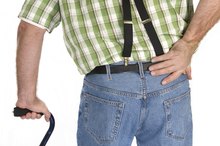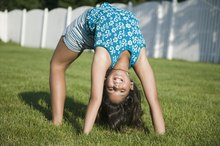Exercises for Stroke Paralysis on One Side
Blocked blood vessels or other injury to the brain can cause a stroke, resulting in one-sided paralysis or difficulty with speech, cognition, swallowing and movement. The right side of the brain affects the left side of the body and vice versa, so the location and severity of the stroke will determine where paralysis may occur. More than 700,000 people each year in the United States are affected by strokes, according to the National Institute of Neurological Disorders and Stroke.
Aerobic Exercise
Physical exercise that encourages rapid exchange of oxygen to muscle tissues, such as aerobic exercise, is recommended for stroke patients, even those who have received some degree of dual or one-sided paralysis. Increasing sensory motor function and aerobic capacity is the goal. Gait belts, support straps or one or more physical therapists may be required to help the patient stand and maintain balance. Handrails may help the patient take steps, depending on his upper body strength and the degree of function loss.
- Physical exercise that encourages rapid exchange of oxygen to muscle tissues, such as aerobic exercise, is recommended for stroke patients, even those who have received some degree of dual or one-sided paralysis.
- Handrails may help the patient take steps, depending on his upper body strength and the degree of function loss.
Physical Conditioning
Limping & Back Pain
Learn More
Balance, coordination and stability are the foundation of starting an exercise program for a partially paralyzed patient, which in turn improve gait and mobility. Active or passive range of motion exercises will help prevent muscles from atrophying, whether full use of the limb is regained or not. Physical conditioning promoted through passive range of motion may improve strength and help the patient to adapt or learn how to gain as much use from damaged limbs as possible.
A passive range of motion exercise for the shoulder requires a physical therapist or family member to gently grasp and support the elbow joint for a shoulder rotation exercise. Extend the patient’s arm slightly out to the side, hand down by the hip. Carefully rotate the patient’s thumb so that the back of the hand is facing forward and the thumb side is closest to the body. Rotate the wrist so that the palm of the hand faces forward and the thumb faces away from the patient's body.
- Balance, coordination and stability are the foundation of starting an exercise program for a partially paralyzed patient, which in turn improve gait and mobility.
- Active or passive range of motion exercises will help prevent muscles from atrophying, whether full use of the limb is regained or not.
Leg Rotations
Maintain lower body musculature by performing passive range of motion exercises for the lower extremities. One exercise focuses on the hip joint. Place the patient on a mat or bed, legs extended straight. Supporting the ankle and knee joint, move the right leg outward and then inward, lifting the leg slightly so it can cross over the left leg. Return to starting position and repeat with the other leg.
- Maintain lower body musculature by performing passive range of motion exercises for the lower extremities.
Related Articles
Writer Bio
Denise Stern is an experienced freelance writer and editor. She has written professionally for more than seven years. Stern regularly provides content for health-related and elder-care websites and has an associate and specialized business degree in health information management and technology.









